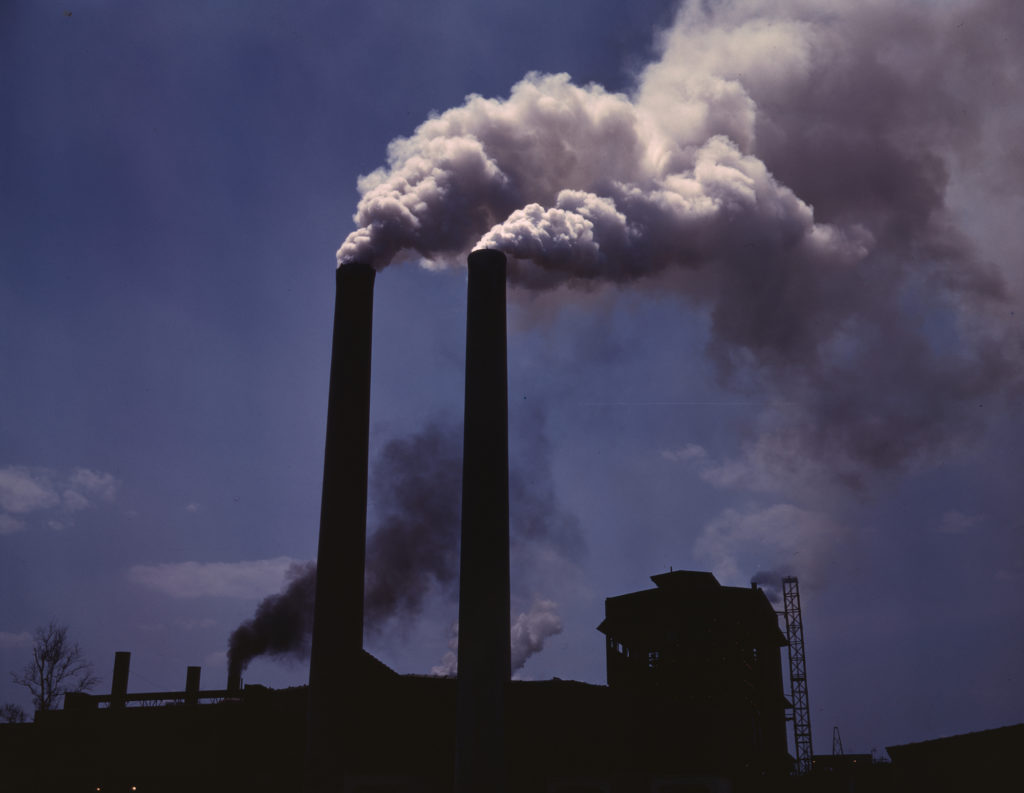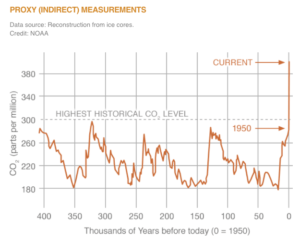Is CO2 Pollution? Not really, but…

Air pollution in this plume is a combination of water vapor (white), carbon (black), and CO2 (invisible). [Photo credit: Alfred Palmer]
Pollutants are usually defined as a contaminant, poison, or toxin that will make the air or water harmful by their presence.
According to the Miriam Webster Dictionary, a pollutant is a substance that makes land, water, air, etc., dirty and not safe or suitable to use.
Common examples might be particulate matter like black carbon (soot) or sulfur dioxide in the air. That can hurt our eyes or make breathing difficult. In drinking water, pesticides, bacteria, or lead are common examples. Any of them are directly harmful to people and would be labeled a pollutant.
Carbon dioxide – CO2 – is not normally harmful to humans. In fact it is part of the life process of all plants and animals as everyone learns in early education. Animals convert oxygen to carbon dioxide. Plants need CO2 to produce oxygen. As a communicator, I cringe at calling carbon dioxide a pollutant. It implies that it is directly harmful.
The problem of CO2 now is an indirect one, related to the level of concentration in the upper atmosphere. For millions of years the level of CO2 has varied roughly between 180 and 280 parts per million (PPM). We can think of that as a natural range, which is tolerable for humans and other advanced life forms.

The problem is that this clear gas, a critical, natural part of the Earth ecosystem, has a super high insulation value, causing it to trap heat, similar to the way glass traps heat in a greenhouse. It has been calculated that without the small amount of CO2, Earth would be sixty degrees Fahrenheit colder (thirty three Celsius), as a global average. We need the right amount of CO2 in the atmosphere, to keep the planet in our temperature range. In effect, CO2 serves as the thermostat, regulating our temperature similar to the way that your thermostat controls the temperature in your home.
One reason that CO2 has been called a pollutant, is that designating it as such brought it under the oversight of U.S. Clean Air Act of 1963 — and other similar international legislation such as the British Clean Air Act in 1953. At the time of the original legislation, the focus of those laws was to control the visible carbon pollution, and the other noxious gases from industry that were causing respiratory problems and “acid rain” damaging trees, buildings, etc. The warming caused by carbon dioxide and other greenhouse gases was not the focus of the clean air efforts.
The air pollution rules were broad enough, however, that they could be modified. Over time they were expanded to include new issues such as the Chlorofluorocarbons (CFC’s) causing the hole in the ozone layer, as well as the very different problem of CO2, methane, and nitrous oxides causing global warming. Thus it was expedient to consider higher levels of these gases as “pollutants” to bring them within the ambit of regulations about the atmosphere.
In fact, at a high enough level, more than 1,000 PPM, carbon dioxide does start to affect humans negatively, causing lethargy and slow thinking. At much higher levels, perhaps 50,000 PPM, CO2 actually would be lethal to humans, but that is not remotely within the range of our problem. Our problem with rising levels of carbon dioxide is that it is warming the planet, to levels not having occurred for millions of years. It is an extremely serious threat. It is a challenge that we have never faced and could not be over-stated in terms of importance.
In doing some research for this explanation, I came across something interesting. In the present online edition of the Encyclopedia Britannica, they have broadened the pollution definition considerably:
Pollution, also called environmental pollution — the addition of any substance (solid, liquid, or gas) or any form of energy (such as heat, sound, or radioactivity) to the environment at a rate faster than it can be dispersed, diluted, decomposed, recycled, or stored in some harmless form. The major kinds of pollution are (classified by environment) air pollution, water pollution, and land pollution. Modern society is also concerned about specific types of pollutants, such as noise pollution, light pollution, and even plastic pollution.
Although environmental pollution can be caused by natural events such as forest fires and active volcanoes, use of the word pollution generally implies that the contaminants have an anthropogenic source—that is, a source created by human activities. Pollution has accompanied humankind ever since groups of people first congregated and remained for a long time in any one place. Indeed, ancient human settlements are frequently recognized by their pollutants—shell mounds and rubble heaps, for instance. Pollution was not a serious problem as long as there was enough space available for each individual or group. However, with the establishment of permanent settlements by great numbers of people, pollution became a problem, and it has remained one ever since.
In effect, the definition of pollutant has been changed to include both the earlier meaning of direct negative effects, as well as the current application for the indirect negative effects such as global warming. With the definition just above, CO2 is quite easily termed a pollutant. I do believe that words and “framing” matter, so that things have context, nuance, and clarity.
The present level of carbon dioxide and the rate it’s increasing go beyond mere pollution. We are altering the atmosphere that supports life as we know it. Regardless of what we call it, we need to reduce the level of carbon dioxide on an absolutely urgent basis. If we don’t, the unraveling of our ecosystem presents an extinction level threat. On Earth Day this year, I shared my position, that what we are doing is not nearly enough to prevent catastrophe: “Earth Day – A call for war time mobilization.”
